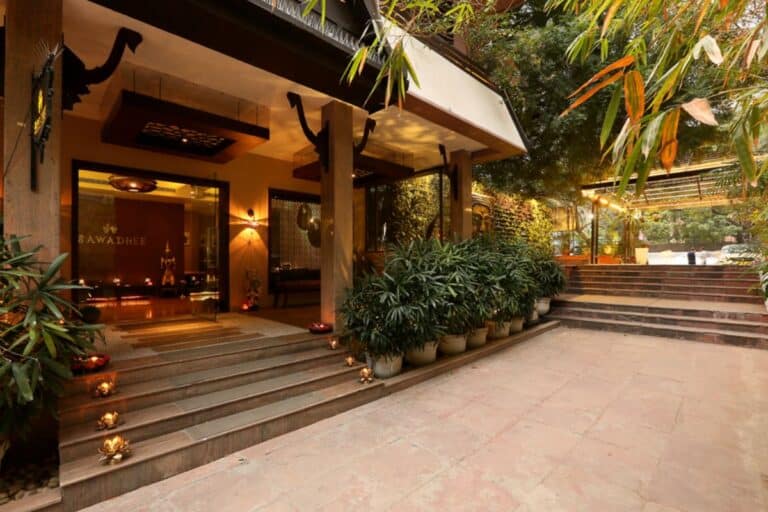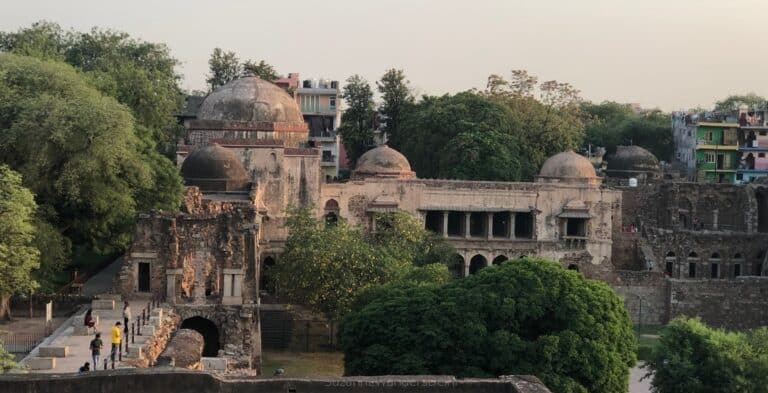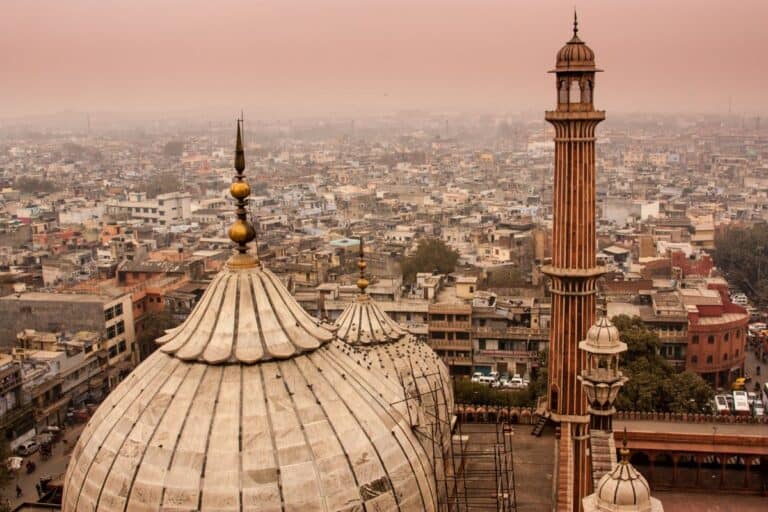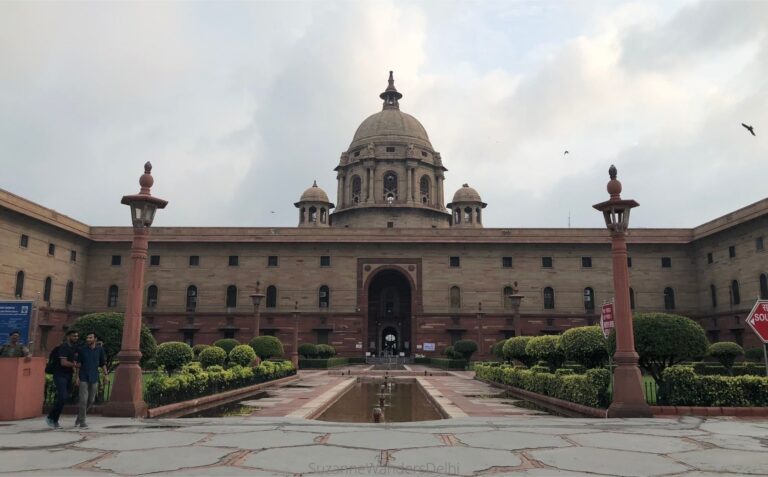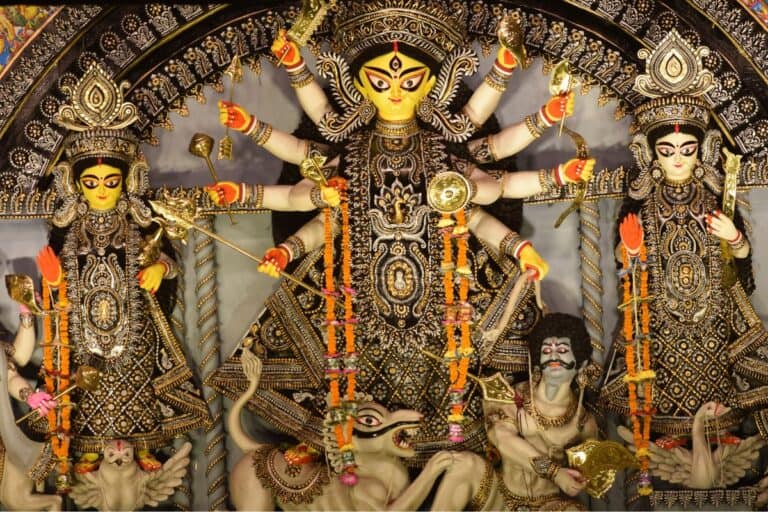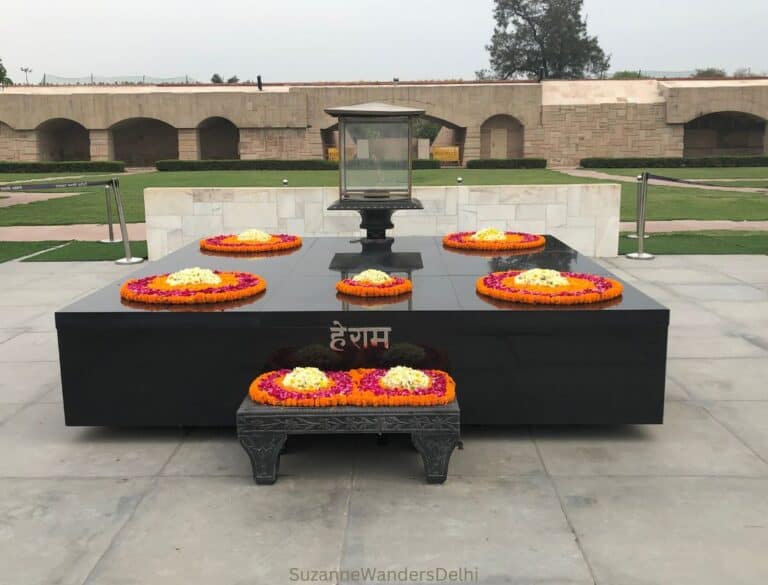Suzanne Wanders Delhi contains affiliate links. If you make a purchase using one of the links below, I may receive compensation at no extra cost to you. I only recommend products and services I use and trust. Read my disclaimer for more information.
Even though Old Delhi has a reputation for being chaotic, it’s still easy to do a self-guided heritage walk. This do it yourself tour will take you to the most important sites, some excellent spots for street food, and let you explore a few lesser known gems in Old Delhi. I live in Delhi and have visited Old Delhi many, many times! These are my top tips and insider’s suggestions.
DIY Heritage Walk of Old Delhi: Quick Guide
If you’re short on time, here is a quick summary of your heritage walk in Old Delhi:
- Jama Masjid (Delhi’s most famous mosque, built in the 17th century)
- Matia Mahal Bazaar and Haji Nadeem Shahi Sheermal (historic bazaar and street food snack)
- Red Fort (UNESCO – fort and palace of the Mughal empire)
- Gurudwara Sis Ganj Sahib (Sikh temple built in 1783)
- Kanwarji Raj Kumar Bhatura Junction (street food lunch break)
- Kinari Bazaar, Naughara and Jain Dharamshala (wedding market, historic havelis and Jain temple)
- Haveli Mirza Ghalib (home of Delhi’s most famous and revered poet, Mirza Ghalib)
- Fatehpuri Masjid (built in 1650 for one of Shah Jahan’s wives)
- Khari Baoli (historic spice market)
- Katra Neel Road (very historic bazaar with many old havelis)
Heritage Walk of Old Delhi
Originally built in the 1600s, many of Old Delhi’s markets, lanes and buildings haven’t changed much. Although very congested and built up now, the general layout of Old Delhi is more or less the same. Old Delhi is a historic treasure, and you’re about to see why it’s on the UNESCO tentative list as a world heritage city. It’s actually the 7th historic city of Delhi, called Shahjahanabad, after emperor Shah Jahan.
Click here for a Google map of the Old Delhi heritage walk.
1. Starting/Meeting Point at Jama Masjid Metro Station
A good meeting point or place to start from is Gate 2 of the Jama Masjid metro station. It’s well marked, everyone can find it and it’s less than a 5 minute walk from your first stop, Jama Masjid. Using the Delhi metro is easy and cheap. I highly recommend it for getting around the city. Walk toward Jama Masjid.
2. Jama Masjid: Delhi’s Largest Mosque
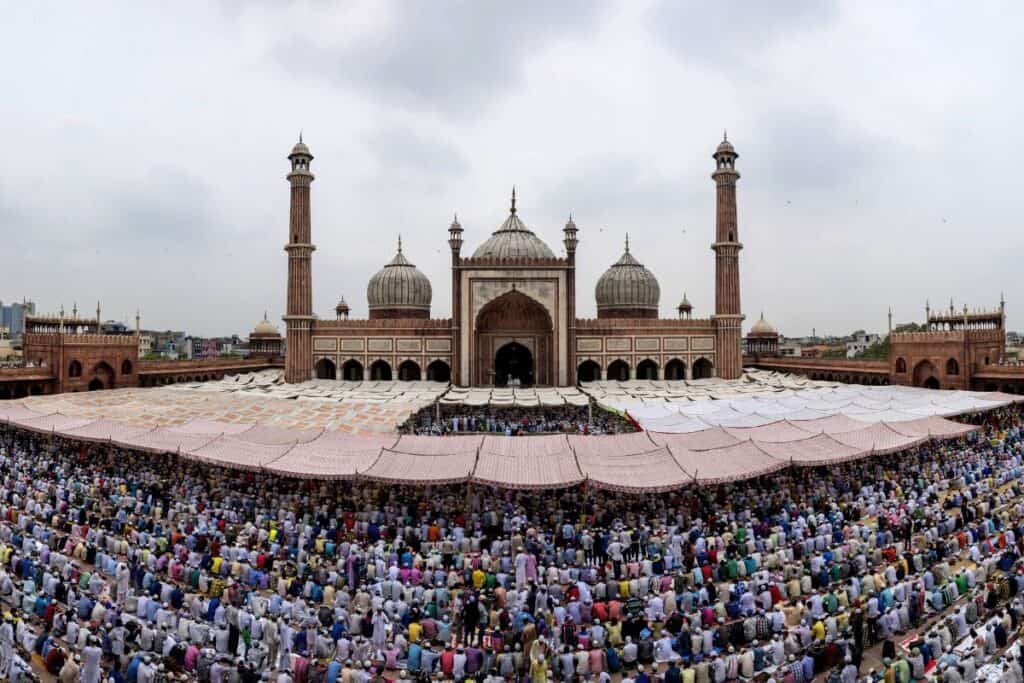
Jama Masjid is Delhi’s largest mosque – it can hold up to 25,000 worshippers at a time. It was built by the emperor Shah Jahan in the 1650s as a mosque for the royal family. It’s a close walk to the Red Fort, the royal palace. You may have heard of Shah Jahan before, he is the ruler who built the Taj Mahal for his favourite wife, Mumtaz Mahal.
This is a beautiful mosque, built of red sandstone and marble. For a small fee you can climb one of the towers. You’ll get spectacular views of Old Delhi from this vantage point. I have also heard there are religious relics from the Prophet Muhammad kept here, and that is possible to view them if you find the right caretaker.
Please keep in mind this is a working mosque, and you may not be allowed in during prayer times. Also be respectful with photos.
There are 3 entrances to the Jama Masjid. Enter at Gate 1 or 2. Shoes must be removed. You can leave them with the shoe minder at the entrance for a small tip (INR 50), or discretely put them in your bag. Women must cover their heads, as well as shoulders and knees (this goes for men too). There are cover ups you can borrow if needed.
Hours and Cost: 7:00 am – 12:00 pm & 1:30 pm – 6:30 pm, daily; free but there is a INR 300 fee for bringing in a camera
3. Matia Mahal Bazaar and Haji Nadeem Shahi Sheermal

It’s time for a snack and some famous Old Delhi street food! Exit Gate 1 of Jama Masjid, cross the road and walk down Matia Mahal Road. This is Matia Mahal Bazaar and it has been here since the 1600s. In fact, while the Red Fort was under construction, Shah Jahan lived in a palace in Matia Mahal. The palace is long gone, but several original palace arches are still in the the lanes of the busy market.
There are many famous Old Delhi eateries here, some are on their 5th or 6th generation, going back to Mughal times. I know it’s probably morning so I’m going to start you off with something easy and delicious – sheermal.
Sheermal is a sweet flatbread made with saffron and topped with dried fruits and nuts. You’ll see it all over Old Delhi, but this place is one of the very best. Haji Nadeem Shahi Sheermal will be on the left side of the street, at the first corner.
Hours and Cost: hours for shops and restaurants vary, but everything is open during the day and into the evening, except on Sunday when the markets are closed; free
4. Red Fort (UNESCO)
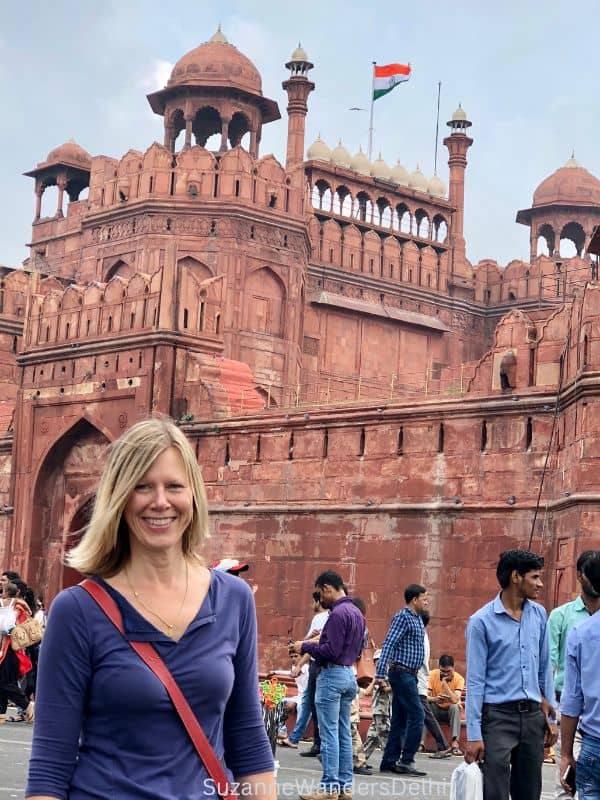
From Matia Mahal Road, walk back toward the Jama Masjid. Hopefully you already purchased your online ticket for the Red Fort and can head straight to the main entrance at Lahori Gate. Otherwise, head to the main ticket book near Delhi Gate.
This is the royal Mughal palace built in 1639 by Shah Jahan, the ruler who built the Taj Mahal in Agra and the Jama Masjid you just visited. It remained the residence of all successive Mughal rulers until the British tossed out the last emperor Bahadur Shah Zafar in 1857. The Red Fort is Delhi’s most visited site, and I recommend you buy your ticket in advance on the Archeological Survey of India website.
When it was a royal palace, the fort was a world unto itself, designed so that nobody had to leave. It had beautiful fountains, gardens, marble audience halls, baths and a covered bazaar. Hundreds worked and lived within the fort. During the Rebellion of 1857 the British destroyed and looted much of it. Whole palace buildings were razed and replaced with ugly army barracks. Today the Red Fort is a far cry from its former splendour, but you can still get an idea of how magnificent it must have been.
There are a group of museums in the old army barracks at Red Fort, including a war museum, art museum and archeological museum. There is an additional fee for these and tickets must be purchased at the Red Fort.
Hours and Cost: 8:00 am – 9:00 pm, daily (closed Monday); INR 600 foreigners (online tickets are INR 550), children under 15 free
If you are visiting around August 15th (Independence Day), check ahead because the fort usually closes to visitors about 10 days before. The Prime Minister addresses the nation from the fort on Independence Day and it is closed for preparations.
5. Temples and Havelis of Chandni Chowk
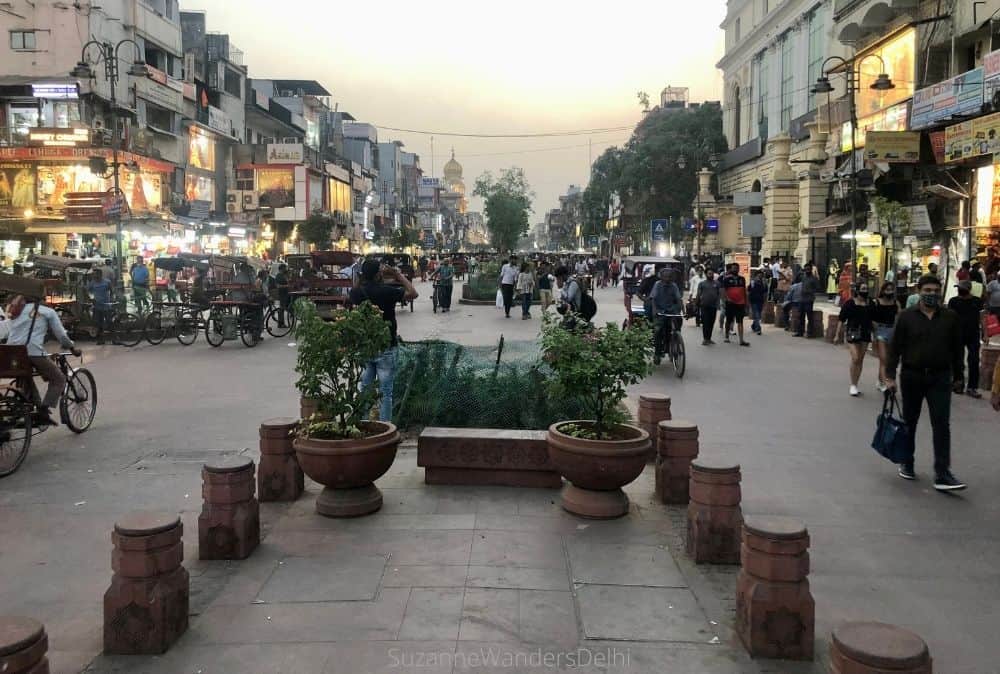
Exit the Red Fort and, cross the street and start walking up Chandni Chowk. Stay on the left side for now. It’s pretty easy to walk across Chandni Chowk since motorized vehicles are banned between 9:00 am and 9:00 pm every day. Some do break the rules, but it’s a lot better than it used to be.
On your left, very close to the Red Fort, is Shri Digambar Jain Lal Mandir & Bird Hospital, a Jain temple built in the 1650s.
The Jains were quite prominent in this area at that time, and the land was gifted to the community by Shah Jahan. Feel free to pop in and take a look. Behind the temple is a charitable bird hospital and visitors are welcome, though I am warning you the floors can be full of droppings. Because the hospital is on temple grounds you have to go barefoot.
Just past the Jain temple you will pass a large Hindu temple with a prominent white dome called the Gauri Shankar Mandir. It was built in the 1950s, but the lingam (a representation of Lord Shiva) inside is 800 years old.
Make sure you look up towards the second and third floors of the buildings you pass. Some of these are traditional 17th century havelis. They’re in pretty sad condition now, but you can imagine how lovely they must have been when Chandni Chowk was lined with gardens and fountains.
Hours and Cost: hours for shops and temples vary, but everything is open during the day and into the evening, except on Sunday when the markets are closed; free
6. Gurudwara Sis Ganj Sahib
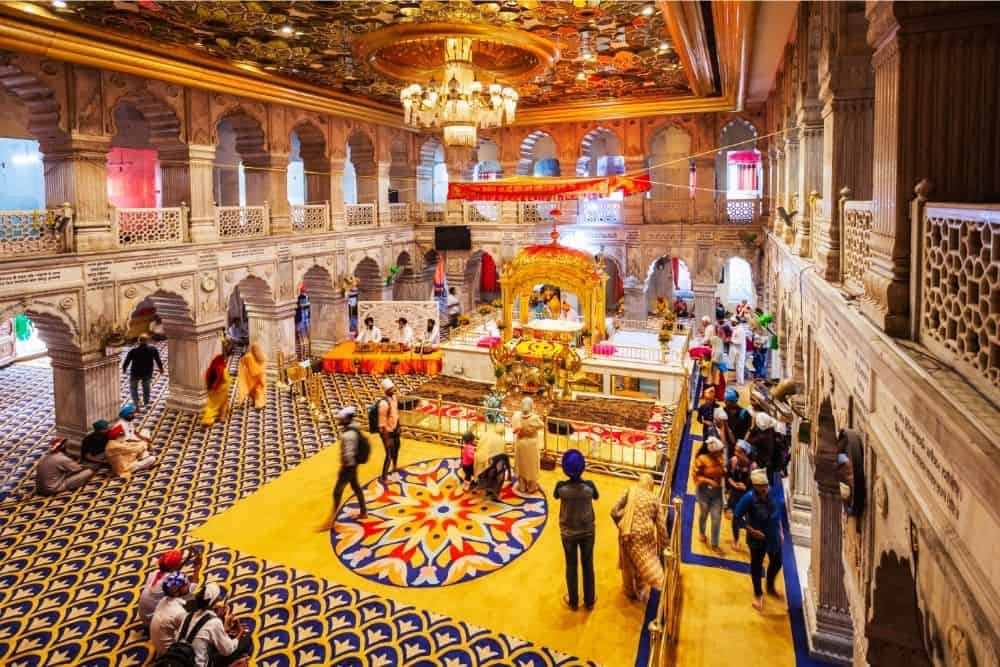
Next is Gurudwara Sis Ganj Sahib, one of the most prominent Sikh temples in India. The original shrine was built in 1783 at the site of the martyrdom of the ninth Sikh Guru, Guru Tegh Bahadur. The Guru was beheaded by emperor Aurangzeb in 1675. The gurudwara takes its name from the Punjabi word for head, ‘sis.’
Aurangzeb was the ruthless son of Shah Jahan (he seized power by imprisoning his father and killing his brothers), and executed the Guru after he refused to convert to Islam.
Despite its past, this is a very peaceful and beautiful gurudwara. Everyone is welcome.
For a very special and culturally authentic experience, join the free vegetarian community meal, langar after visiting the temple. It is in the dining hall. Everyone is welcome to have langar, regardless of religion or nationality.
You must remove your shoes and cover your head to enter the temple. Bandanas are available to borrow.
Hours and Cost: 24/7; free
7. Lunch at Kanwarji Raj Kumar Bhatura Junction
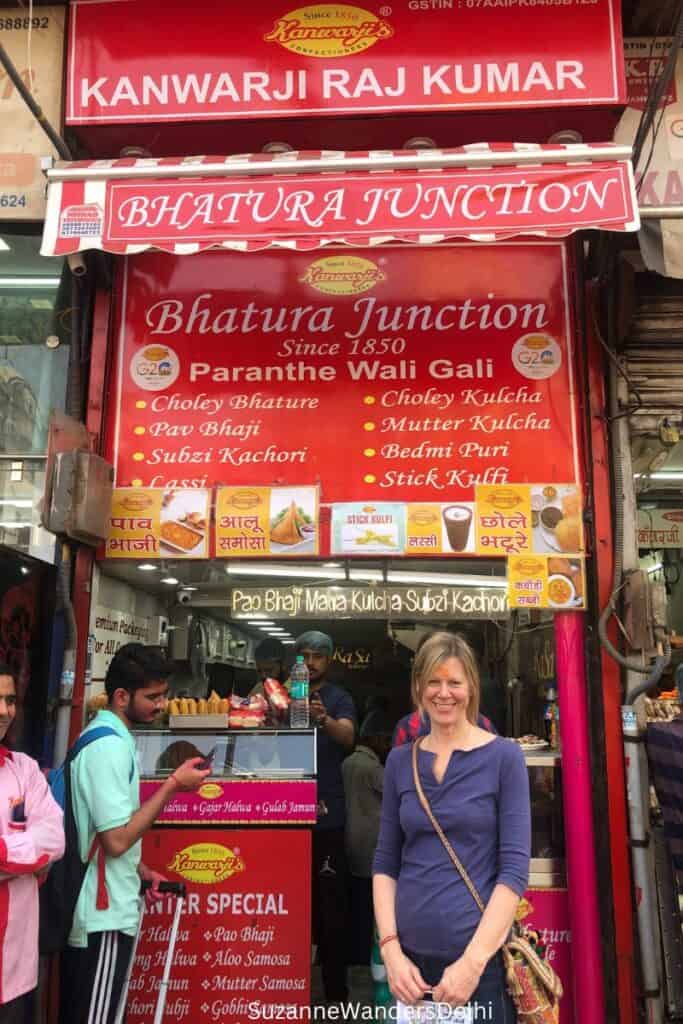
It’s time for one of the most real Delhi experiences you can have – eating lunch like a local in Delhi-6! Delhi-6 is what locals fondly call this part of Old Delhi. It refers to the postal code.
As you exit Gurudwara Sis Ganj Sahib, go left and continue walking along Chandni Chowk. In less than 5 minutes you’ll see the Kanwarji Raj Kumar bhatura stand. Bhatura are puffy fried breads and are often served with chole, a rich chickpea curry. That is exactly what you should order here: chole bhatura. It is one of the very best in the city.
You have to pay for your food around the corner at the window where they sell the sweets (this is actually a very famous snack and sweet shop). Grab your receipt and go back to the bhatura stand and hand it over to the guy behind the counter.
Once your order is ready, grab a seat wherever you can find one (I often eat on the benches in the median), dig in, and enjoy eating like a Delhi local.
Everything is cooked and should be safe to eat. I’ve eaten her numerous times and never had a problem. You’ll be using your hands, so if you have sanitizer wipes it would be smart to use them now! I’m pretty sure half the time people get ‘delhi belly’ is not from the food, but from the bacteria on their hands. If you are worried, you can see my tips on how to eat street food safely.
Hours and Cost: 9:00 am – 9:00 pm, daily; about INR 100 for chole bhatura
8. Kinari Bazaar, Naughara Gali and Jain Dharamshala
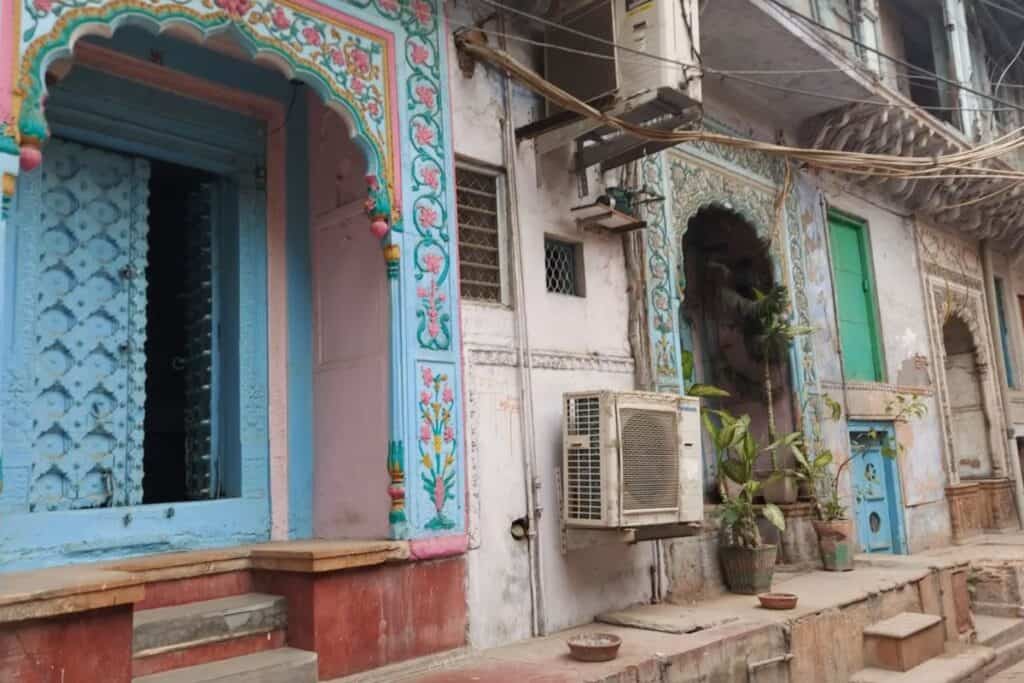
Go back to the window where you paid for your food at Kanwarji Raj Kumar Bhatura Junction and walk down this lane. This is the beginning of Kinari Bazaar, the wedding market. Chandni Chowk is full of these historic, specialty bazaars and Kinari Bazaar is one of the most popular and famous. These lanes and bazaars were here in the 1600s, you are literally walking the streets of history.
Kinari Bazaar is where you’ll find all kinds of trinkets and adornments used in Indian weddings. The lanes are windy, narrow and full of interesting shops. You can pick up all sorts of lace, trim, beads and embellishments at great prices, especially if you can bargain. You will walk past Parantha Wali Gali, the lane full of parantha shops. If you enjoy the stuffed Indian flatbreads, you’ll be bowled over by the variety here. The first parantha shops opened in this lane in 1872.
To find Naughara Gali, take a left down another lane just a bit past the parantha area, and then a right. Naughara Gali and the Jain temple are marked on Google maps – I recommend you navigate using this. If you don’t have data, ask a local.
Naughara Gali is a lane with 9 historic havelis from the 1700s. They are all on this small alley that ends with the Jain Svetambar temple. The havelis are subject to heritage restrictions and must maintain the exterior in the original style. The doorways and elevations are typical Mughal design, with latticed balconies and arched doorways carved with flowers and vines. These homes were, and many still are, owned by wealthy jewelry families.
Continue to the end and take a look inside the Jain temple. Parts of the temple are believed to be 2500 years old.
Hours and Cost: 24/7; free
9. Haveli Mirza Ghalib
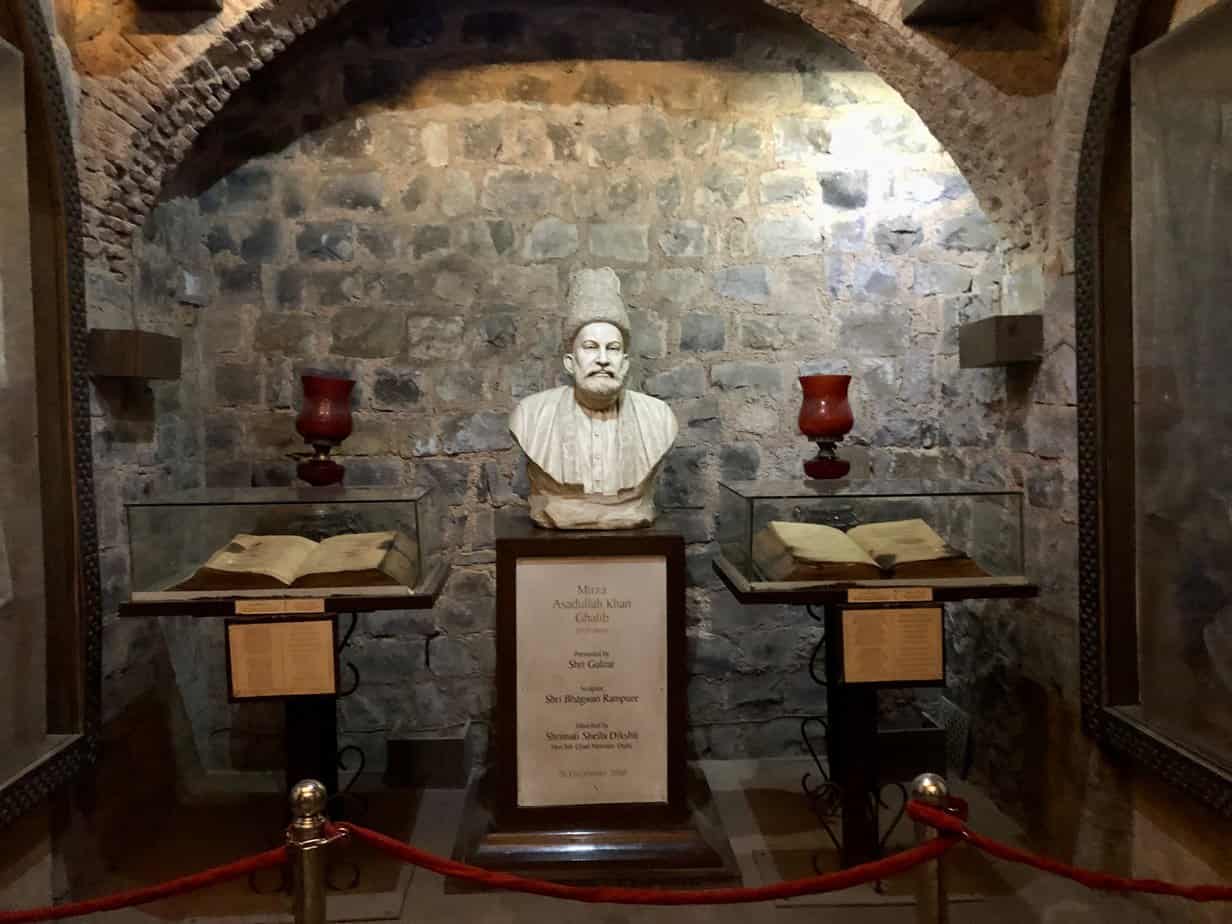
Use Google maps to help you navigate through the lanes of Old Delhi to Haveli Mirza Ghalib. You can also walk back to Chandni Chowk and go from there, but why back-track when you can walk the lanes and see the real Delhi-6?
This is the historic home of the last Mughal poet, Mirza Asadullah Khan Ghalib. His poetry is part of the cultural heritage of Delhi. Ghalib is widely accepted as the greatest of the Mughal poets. He lived through the decline of the empire and was a poetry tutor of the last ruler, Bahadur Shah Zafar.
Ghalib wrote painful, beautiful poems about the destruction of Shahjahanabad (what is now Old Delhi) during the Rebellion of 1857. The lovely old city was looted and destroyed by British forces at that time, and Ghalib was witness to it all.
The haveli was much cleaner and more beautiful during Ghalib’s time, but the narrow lanes and architecture have not changed much. You can also visit Ghalib’s grave in Chausath Khamba.
Hours and Cost: 10:00 am – 6:00 pm, Tuesday to Sunday (closed Monday); free
10. Fatehpuri Masjid
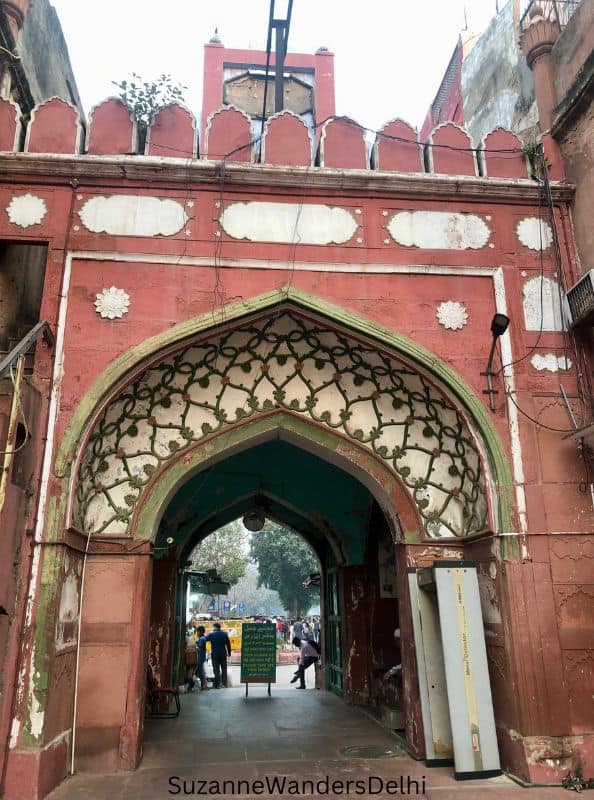
From Ghalib’s haveli, head up Ballimaran Road back to Chandni Chowk. Turn left onto Chandni Chowk and take it to the end, in front of Fatehpuri Masjid.
The mosque was built in 1650 for Fatehpuri Begum, who was a wife of Mughal ruler Shah Jahan. During the Rebellion of 1857 British troops occupied the mosque. Soldiers looted and destroyed the fountains and carvings, some even carved their own names into the red sandstone arches.
The mosque was later auctioned off to a wealthy Hindu merchant who sold it back to the British, and 20 years later it was finally returned to the Muslim community. You’ll notice there are some prominent graves in the courtyard. These belong to Islamic scholars and past Imams of the mosque.
This is a working mosque, so shoes must be removed and women must cover their heads. Conservative dress is required.
Hours and Cost: 6:00 am – 8:00 pm, daily; free
11. Khari Baoli – Old Delhi’s Spice Market
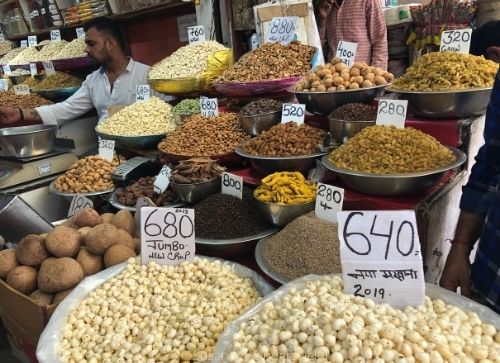
Exit Fatehpuri Masjid through the north gate and you will find yourself in Khari Baoli, Asia’s largest wholesale spice market. The market is named after an ancient saltwater stepwell that was at this location, but has long since dried up.
Khari Baoli has been here for many years, some of these shops have been in the same family for 10 generations.
This is the perfect place to pick up fresh spices, dried fruit, nuts and loose tea. But don’t buy from the first shop. Head further into the market to get better prices. Khari Baoli is on just about every Old Delhi walking tour and gets a lot of tourists. Prices will be inflated, especially if you look like a foreigner.
Be prepared, the market is an assault on the olfactory senses! I cannot walk through here without sneezing.
Hours and Cost: 11:30 am – 6:00 pm, daily (closed Sunday); free
12. Katra Neel Road
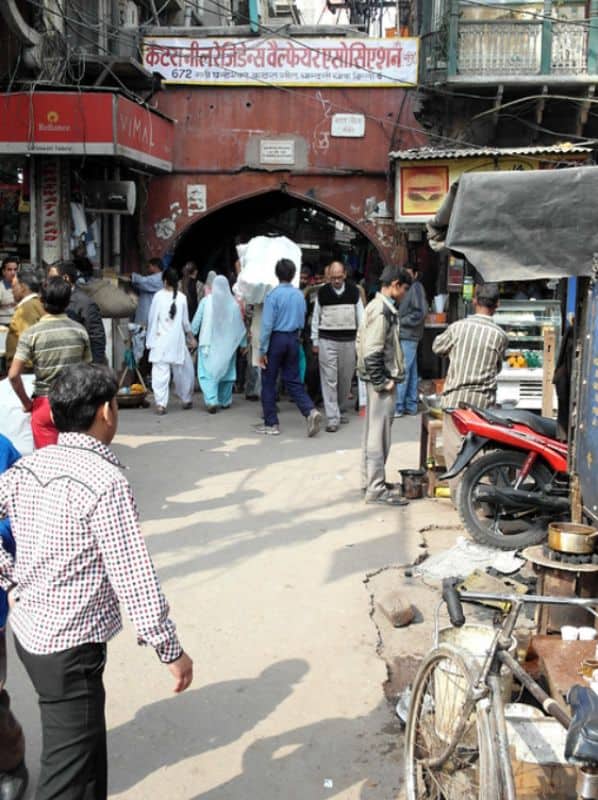
From Khari Baoli walk back across Chandni Chowk on the opposite side of the street this time. If you took the metro, you can walk to Chandni Chowk metro station by way of Katra Neel Road. Katra Neel market is known for cloth and Indian wedding clothing.
The area was established during Shah Jahan’s time and you’ll find many examples of Mughal architecture and old havelis if you look. You’ll also see a stone arched gate, Katra Neel Gateway, built in 1857 but now off limits as a portion recently collapsed. Many of the old haveli courtyards have a Shivalay (shrine to Lord Shiva), and Katra Neel is known for this. If you have the chance, look into the courtyards to see the Shivalays.
This market is significant in the heritage of Old Delhi. It was here the rebels lived during the revolts of 1857, and many were hanged here by the British.
From Katra Neel, walk through Mahatma Gandhi Park (behind Town Hall – look for the clock tower) and toward the Chandni Chowk metro station. This is where your DIY Old Delhi heritage walk ends. There are many great places to eat in Old Delhi if you’re not ready to call it a day.
Hours and Cost: 11:00 am – 9:00 pm, (market closed Sunday); free
Know Before You Go on Your Old Delhi Heritage Walk
- Old Delhi is noisy and very congested
- Chandni Chowk markets and many shops are closed on Sunday
- Red Fort is closed on Monday
- buy Red Fort tickets in advance online on the Archeological Survey of India website
- wear comfortable shoes that are easy to slip on and off
- you can take a bicycle rickshaw any time you don’t want to walk
- keep small bills for shoe minders at temples, bicycle rickshaw drivers and to buy bottled water
- dress conservatively and bring a dupatta/head scarf (men should bring a bandana if they have one)
- only drink bottled water
- 100% ignore the touts
FAQ About a Heritage Walk in Old Delhi
The heritage walk is a way to explore the rich culture, history and food of Old Delhi on foot.
Prices vary, but generally they are INR 1,000 – 3,000 per person.
Old Delhi is the historic part of the city, built primarily by Shah Jahan in the 1650s. New Delhi was built by the British in 1911 to house parliament and the government administration of India. Officially New Delhi is a union territory and is the capital of India. Both Old Delhi and New Delhi are parts of the Indian mega city of Delhi.
Shahjahanabad is now called Old Delhi. It was the walled city built by Shah Jahan in the 1650s.
Guided Heritage Walks of Old Delhi
If you prefer to take a guided tour of Old Delhi, I can recommend these companies:
Delhi Tourism recently launched a series of cultural Delhi walks which can be booked online through their website. Cost starts at INR 800 plus GST. A minimum of 6 participants are required to conduct each walk.
Check Delhi Tourism heritage walks and book online
The Wrap-up on Heritage Walk of Old Delhi: an Insider’s DIY Tour
Doing a self-guided heritage walk of Old Delhi is absolutely manageable. Follow this itinerary as your guide, but don’t be afraid to veer off and explore. Just about every nook and cranny of Old Delhi is interesting and has a story to tell. If
If you liked this self-guided heritage walk of Old Delhi, you might also like this self-guided street food walk of Old Delhi.
Don’t forget travel insurance! It’s always a good idea to carry travel insurance just in case something goes wrong. I really like and use SafetyWing

